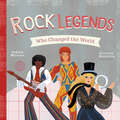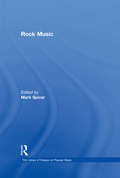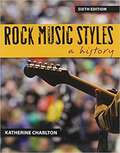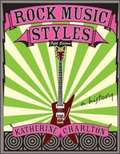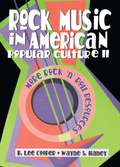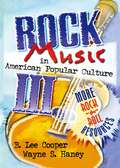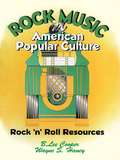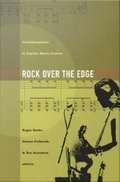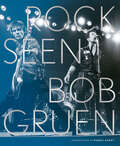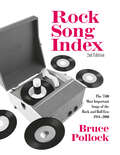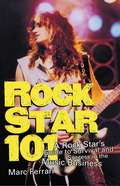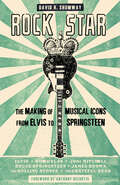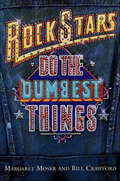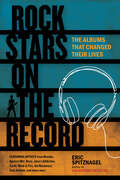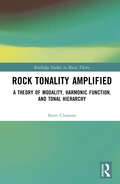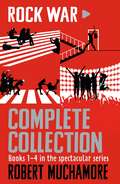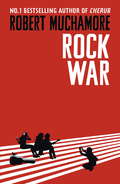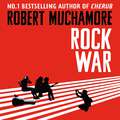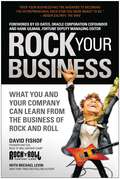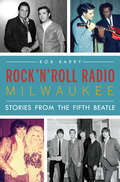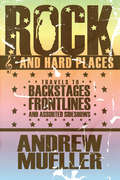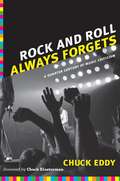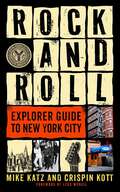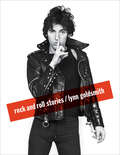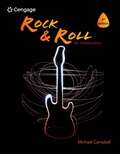- Table View
- List View
Rock Legends Who Changed the World (People Who Changed the World)
by Ashley Marie MirelesA board book tribute to music icons—from Buddy Holly to Queen—who changed rock and roll forever!
Rock Music (The\library Of Essays On Popular Music Ser.)
by Mark SpicerThis volume gathers together twenty articles from among the best scholarly writing on rock music published in academic journals over the past two decades. These diverse essays reflect the wide range of approaches that scholars in various disciplines have applied to the study of rock, from those that address mainly the historical, sociological, cultural and technological factors that gave rise to this music, to those that focus primarily on analysis of the music itself. This collection of articles, some of which are now out of print or otherwise difficult to access, provides an overview of the current state of research in the field of rock music, and includes an introduction which contributes to the ongoing debate over the distinction (or lack thereof) betweenrock andpop.
Rock Music Styles
by Katherine CharltonRock Music Styles: A History blends musical commentary into an historical and social framework as it traces the development of rock music from its roots in the blues, country, gospel, and other pre-rock music through the decades to the most contemporary styles of rock music. <p><p> The book features a series of detailed listening guides that explore examples of the genre in significant musical detail, enabling students to connect the popular music of yesterday with that of today.
Rock Music Styles: A History, 5th Edition
by Katherine CharltonRock Music Styles blends musical commentary into an historical and social framework as it traces the development of rock music from its roots in country and blues to the most contemporary trends. Through well-chosen song examples and easy-to-read listening guides, students will experience firsthand the defining characteristics of rock styles and develop the ability to make connections between the popular music of yesterday and today.
Rock Music in American Popular Culture II: More Rock 'n' Roll Resources
by Frank Hoffmann B Lee Cooper Wayne S Haney Beulah B RamirezFrom “Who Put the Bomp (in the Bomp, Bomp, Bomp)?” to a list of all song titles containing the word “werewolf,” Rock Music in American Popular Culture II: More Rock ’n’Roll Resources continues where 1995’s Volume I left off. Using references and illustrations drawn from contemporary lyrics and supported by historical and sociological research on popular cultural subjects, this collection of insightful essays and reviews assesses the involvement of musical imagery in personal issues, in social and political matters, and in key socialization activities. From marriage and sex to public schools and youth culture, readers discover how popular culture can be used to explore American values. As Authors B. Lee Cooper and Wayne S. Haney prove that integrated popular culture is the product of commercial interaction with public interest and values rather than a random phenomena, they entertainingly and knowledgeably cover such topics as: answer songs--interchanges involving social events and lyrical commentaries as explored in response recordings horror films--translations and transformations of literary images and motion picture figures into popular song characters and tales public schools--images of formal educational practices and informal learning processes in popular song lyrics sex--suggestive tales and censorship challenges within the popular music realm war--examinations of persistent military and home front themes featured in wartime recordingsRock Music in American Popular Culture II: More Rock ‘n’Roll Resources is nontechnical, written in a clear and concise fashion, and explores each topic thoroughly, with ample discographic and bibliographic resources provided for additional research. Arranged alphabetically for quick and easy reference to specific topics, the book is equally enjoyable to read straight through. Rock music fans, teachers, popular culture professors, music instructors, public librarians, sound recording archivists, sociologists, social critics, and journalists can all learn something, as the book shows them the cross-pollination of music and social life in the United States.
Rock Music in American Popular Culture III: More Rock 'n' Roll Resources
by Frank Hoffmann B Lee Cooper Wayne S HaneyRock Music in American Popular Culture III: More Rock ’n’Roll Resources explores the fascinating world of rock music and examines how this medium functions as an expression of cultural and social identity. This nostalgic guide explores the meanings and messages behind some of the most popular rock ’n’roll songs that captured the American spirit, mirrored society, and reflected events in our history. Arranged by themes, Rock Music in American Popular Culture III examines a variety of social and cultural topics with related songs, such as: sex and censorship--“Only the Good Die Young” by Billy Joel and “Night Moves” by Bob Seger and The Silver Bullet Band holiday songs--“Rockin’Around the Christmas Tree” by Brenda Lee and “The Christmas Song” by Nat King Cole death--“Leader of the Pack” by The Shangri-Las and “The Unknown Soldier” by The Doors foolish behavior--“When a Man Loves a Woman” by Percy Sledge and “What Kind of Fool” by Barbra Streisand and Barry Gibb jobs and the workplace--“Don’t Stand So Close to Me” by The Police and “Dirty Laundry” by Don Henley military involvements--“Boogie Woogie Bugle Boy” by the Andrews Sisters and “War” by Edwin Starr novelty recordings--“The Purple People Eater” by Sheb Wooley and “Eat It” by Weird Al Yankovic letters and postal images--“P. S. I Love You” by The Beatles and “Return to Sender” by Elvis PreselyIn addition, a discography and a bibliography after each section give further examples of the themes and resources being discussed, as do extensive lists of print references at the end of the text.
Rock Music in American Popular Culture: Rock 'n' Roll Resources
by Frank Hoffmann B Lee Cooper Wayne S HaneyHow does rock music impact culture? According to authors B. Lee Cooper and Wayne S. Haney, it is central to the definition of society and has had a great impact on shaping American culture. In Rock Music in American Popular Culture, insightful essays and book reviews explore ways popular culture items can be used to explore American values. This fascinating book is arranged alphabetically for quick and easy reference to specific topics, but the book is equally enjoyable to read straight through.The influence of rock era music is evident throughout the text, demonstrating how various topics in the popular culture field are interconnected. Students in popular culture survey courses and American studies classes will be fascinated by these unique explorations of how family businesses, games, nursery rhymes, rock and roll legends, and other musical ventures shed light on our society and how they have shaped American values over the years.
Rock Over the Edge: Transformations in Popular Music Culture
by Roger Beebe Denise Fulbrook Ben SaundersThis collection brings new voices and new perspectives to the study of popular--and particularly rock--music. Focusing on a variety of artists and music forms, Rock Over the Edge asks what happens to rock criticism when rock is no longer a coherent concept. To work toward an answer, contributors investigate previously neglected genres and styles, such as "lo fi," alternative country, and "rock en español," while offering a fresh look at such familiar figures as Elvis Presley, the Beatles, and Kurt Cobain. Bridging the disciplines of musicology and cultural studies, the collection has two primary goals: to seek out a language for talking about music culture and to look at the relationship of music to culture in general. The editors' introduction provides a backward glance at recent rock criticism and also looks to the future of the rapidly expanding discipline of popular music studies. Taking seriously the implications of critical theory for the study of non-literary aesthetic endeavors, the volume also addresses such issues as the affective power of popular music and the psychic construction of fandom. Rock Over the Edge will appeal to scholars and students in popular music studies and American Studies as well as general readers interested in popular music. Contributors. Ian Balfour, Roger Beebe, Michael Coyle, Robert Fink, Denise Fulbrook, Tony Grajeda, Lawrence Grossberg, Trent Hill, Josh Kun, Jason Middleton, Lisa Ann Parks, Ben Saunders, John J. Sheinbaum, Gayle Wald, Warren Zanes
Rock Seen
by Bob Gruen&“The official monograph of rock and roll&’smost famous photographer, Rock Seen is a must-have for all rock fans.&” (RollingStone.com) For forty years, Bob Gruen&’s name has been synonymous with rock and roll. From taking early photos on tour with Ike and Tina Turner, to capturing the early CBGB/Max&’s Kansas City scene to covering current stadium rockers such as Green Day, Gruen has always been at the right place at the right time—and he&’s always gotten the shot. In this lavish monograph, Gruen has curated his favorite photographs from his career, with intimate captions and behind-the-scenes anecdotes. Featuring such illustrious acts as the Clash, Led Zeppelin, the Rolling Stones, Sex Pistols, Ramones, and more, and including an introduction by the legendary Debbie Harry of Blondie, this collection is a must-have for all fans of rock and roll. &“Rock Seen offers a disarmingly natural look at icons like Blondie and Cher before the era of the posed rock-star portrait kicked in.&” —Entertainment Weekly &“Rock Seen . . . hits the high points on and off the stage in rock&’s past four decades.&” —USA Today &“Go backstage with forty years&’ worth of rock-and-roll images from the legendary lens of Bob Gruen. . . . From over-the-top action shots of Elton John&’s acrobatics to private pics of Lennon and Yoko in bed with baby Sean to boozy plane rides with the Sex Pistols, the glossy pages act as your VIP pass to the rock-star lifestyle you&’ve dreamed of.&” —Marie Claire &“Gruen had a front-row seat to the rise of many rock legends [from] Elton John to Green Day.&” —The New York Post
Rock Song Index: The 7500 Most Important Songs for the Rock and Roll Era
by Bruce PollockThe Rock Song Index, Second Edition, is a new version of a well-received index to the classic songs of the rock canon, from the late '40s through the end of the 20th century. The study of the history of rock music has exploded over the last decade; all college music departments offer a basic rock-history course, covering the classic artists and their songs.
Rock Star 101: A Rock Star's Guide to Survival and Success in the Music Business
by Marc FerrariA successful rock guitarist shares with musicians at every level firsthand knowledge of how to endure and triumph in the music industry. Rock-and-roll dreams become realities with this guide. Packed with advice and entertaining stories from life on stage and on the road, Rock Star 101 tells musicians on the rise how to: Understand the business and legal elements of the music industry: negotiations, contracts, publishing, merchandising, endorsements, money management, & more Protect a band from legal and financial conflicts Negotiate a "key man clause" and other crucial contract elements Find sideline work in music-related fields Set up convincing showcases or auditions with recording labels Develop a long-term perspective for one's musical success
Rock Star: The Making of Musical Icons from Elvis to Springsteen
by David R. ShumwayThe nature and meaning of rock stardom—celebrities who embody the most important social and cultural conflicts of their era."All stars are celebrities, but not all celebrities are stars," states David Shumway in the introduction to Rock Star, an informal history of rock stardom. This deceptively simple statement belies the complex definition and meaning of stardom and more specifically of rock icons. Shumway looks at the careers and cultural legacies of seven rock stars in the context of popular music and culture—Elvis Presley, James Brown, Bob Dylan, the Rolling Stones, the Grateful Dead, Joni Mitchell, and Bruce Springsteen. Granted, there are many more names that fall into the rock icon category and that might rightfully appear on this list. Partly, that is the point: "rock star" is a familiar and desired category but also a contested one.Shumway investigates the rock star as a particular kind of cultural construction, different from mere celebrity. After the golden age of moviemaking, media exposure allowed rock stars more political sway than Hollywood's studio stars, and rock stars gradually replaced movie stars as key cultural heroes. Because of changes in American society and the media industries, rock stars have become much more explicitly political figures than were the stars of Hollywood’s studio era. Rock stars, moreover, are icons of change, though not always progressive, whose public personas read like texts produced collaboratively by the performers themselves, their managers, and record companies. These stars thrive in a variety of media, including recorded music, concert performance, dress, staging, cover art, films, television, video, print, and others.Filled with memorable photographs, Rock Star will appeal to anyone interested in modern American popular culture or music history.
Rock Stars Do the Dumbest Things
by Bill Crawford Margaret MoserAerosmith. Elvis Presley. Michael Jackson. Nine Inch Nails. Ozzy Osbourne. U2. What do all of these artists have in common? They're rich and rowdy rock 'n' roll renegades whose wild stunts, dumb quotes, and out-of-control lifestyles are featured in Rock Stars Do the Dumbest Things.--Where else will you find an explanation (goodness knows, we need one) of the Spice Girls' fourteen and one-half minutes of fame straight from the mouths of babes--Baby Spice, that is? "We're like a religious cult."--Or where will you learn Izzy Stradlin's (of Guns N' Roses) deep thoughts on the virtues of vomiting out of a bus going sixty-five miles an hour?--And how live octopuses end up in a bathtub with Led Zepplin's female playmates?Whether you're a Metallica or Madonna fan, you'll get plenty of jaw-dropping facts and anecdotes, along with biographical and career highlights of over eighty-eight raunchy rock 'n' rollers.From current starts like Marilyn Manson and Courtney Love, to classic rockers like the Rolling Stones and the Eagles, Rock Stars Do the Dumbest Things is proof that rock music is still crazy after all these years.
Rock Stars on the Record: The Albums That Changed Their Lives
by Eric SpitznagelAn all-star lineup of rock-n-rollers relay the uproariously wild, sentimental, and unexpected pre-stardom stories behind their favorite records.Rock Stars on the Record is a collection of first-hand tales by artists of all ages, backgrounds, and musical influences, remembering the meaning behind the records that mattered most to them. From Laura Jane Grace to Ian MacKaye, Don McLean to Cherie Currie, Alice Bag to Mac DeMarco, Perry Farrell to Suzi Quatro and Verdine White, and many more, bestselling author Eric Spitznagel talks to rock stars across the sonic spectrum about the albums that changed them in ways only music can change someone. Everyone&’s most cherished childhood record―be it a battered piece of vinyl, torn cassette tape, or scratched CD―has a story, and those stories can be more revealing about their owners than you might expect. Read about how &“Weird Al&” Yankovic refined his accordion skills by playing along to Elton John&’s Goodbye Yellow Brick Road, or how Fishbone&’s Angelo Moore saved his life with a boombox and a Bad Brains album. Or about how Wendy Melvoin and Lisa Coleman of Prince&’s longtime band, The Revolution, fell in love while trading mixtapes. Each profile is more emotional, fascinating, and hilarious than the last. So place that needle in the groove, and prepare to hear something revelatory from your favorite rockers past and present. &“Absolutely fascinating. It&’s hard to believe that no one has done this before, but now that I&’ve read it, it seems totally obvious―except that most journalists wouldn&’t be able to get people to talk so openly and compellingly about something that, to an artist, may feel very private. I know these great musicians and their music better now. Thank you, Eric.&” —Daniel J. Levitin, bestselling author of This Is Your Brain on Music, professor of Neuroscience and Music at McGill University in Montreal &“In asking a slew of rock stars about the record that changed their lives, Eric Spitznagel also ferrets out fascinating backstories and unexpected anecdotes. Who knew that Tommy Roe&’s granddaughter calls him &‘the Justin Bieber of the &‘60s&’? Or that Perry Farrell entertained his older siblings&’ friends&’ by dancing the Hully Gully at their parties? Rock Stars on the Record is so much fun, and more illuminating that you&’d expect.&” —Caroline Sullivan, author of Bye Bye Baby: My Tragic Love Affair with the Bay City Rollers
Rock Tonality Amplified: A Theory of Modality, Harmonic Function, and Tonal Hierarchy (Routledge Studies in Music Theory)
by Brett ClementRock Tonality Amplified presents an in-depth exploration of rock tonality. Building on several decades of research, this book develops a comprehensive music theory designed to make sense of several essential components of tonality. Within, readers learn to locate the chords they hear through various methods, to understand and predict harmonic resolution tendencies, and to identify the functions of chords as they appear in musical contexts. Further, the book offers a conceptual framework to describe tonal relations that are played out through entire songs, allowing readers to recognize the features that contribute to tonal unity in songs and the ones that are employed to create musical drama. The book contributes to a wealth of methodologies in music theory, making it of broad interest to music scholars and students. Further, it balances speculative and practical approaches so that it has clear applications for analysis and pedagogy. It includes numerous musical figures and cites hundreds of songs from a wide variety of artists. Each chapter concludes with additional practice activities, allowing for easy adaptation to various pedagogical purposes.
Rock War Complete Collection: Books 1-4 in the spectacular series (Rock War #104)
by Robert MuchamoreAll four books in Robert Muchamore's spectacular Rock War series Rock War (Book 1): Meet Jay. Summer. And Dylan. Jay plays guitar, writes songs and dreams of being a rock star. But his ambitions are stifled by seven siblings and a terrible drummer. Summer works hard at school, looks after her nan and has a one-in-a-million singing voice. But can her talent triumph over her nerves? Dylan is happiest lying on his bunk smoking, but his school rugby coach has other ideas, and Dylan reluctantly joins a band to avoid crunching tackles and icy mud. They're about to enter the biggest battle of their lives. And there's everything to play for. Boot Camp (Book 2):Jay, Summer, Dylan and their bands are headed for boot camp at uber-glamorous Rock War Manor. It's going to be six weeks of mates, music and non-stop partying as they prepare for stardom. But the rock-star life of music festivals and glitzy premieres isn't all it's cracked up to be. Can the bands hold it together long enough to make it through the last stage of the competition, or will there be meltdown? Gone Wild (Book 3): The Rock War TV show is the most-watched reality show on British telly, and it's only halfway through. Jay, Summer, Dylan and their bands have all made it past the tough boot camp stage, and now the last six will fight it out until the season's finale, live on Christmas Eve. But it's not all about the music. Summer was hit by a motorbike at the end of boot camp. Jay's brother, Theo, can't keep out of trouble - or out of handcuffs. And Dylan, the outsider, is investigating corruption within the workings of the competition itself. Crash Landing (Book 4):Jay, Summer and Dylan are fresh out of the biggest reality show there is. But they're about to discover what fame and fortune are really about. Jay's brother, Theo, is young, rich and famous: but is it making him happy? Summer's got to weather her one-star reviews and take her career back into her own hands. And Dylan might soon be seeing the world of show-business from the four walls of a prison cell.They've got everything to play for ... From the author of CHERUB and Henderson's Boys: find out more at rockwar.com Praise for the CHERUB series: 'Punchy, exciting, glamorous and, what's more, you'll completely wish it was true' - Sunday Express 'Crackling tension and high-octane drama' - Daily Mail 'A really good book that you could re-read over and over again' - Guardian 'Pacy writing, punchy dialogue and a gripping plot, it's got it all' - Daily Express 'Fast-moving action ... and cool gadgets!' - The Times
Rock War: Book 1 (Rock War #1)
by Robert MuchamoreMeet Jay. Summer. And Dylan. Jay plays guitar, writes songs and dreams of being a rock star. But his ambitions are stifled by seven siblings and a terrible drummer. Summer works hard at school, looks after her nan and has a one-in-a-million singing voice. But can her talent triumph over her nerves?Dylan is happiest lying on his bunk smoking, but his school rugby coach has other ideas, and Dylan reluctantly joins a band to avoid crunching tackles and icy mud.They're about to enter the biggest battle of their lives. And there's everything to play for. A spectacular start to the new series from Robert Muchamore, bestselling author of CHERUB - read on with Rock War: The Audition, a story especially written for World Book Day.
Rock War: Book 1 (Rock War #1)
by Robert MuchamoreMeet Jay. Summer. And Dylan. Jay plays guitar, writes songs and dreams of being a rock star. But his ambitions are stifled by seven siblings and a terrible drummer. Summer works hard at school, looks after her nan and has a one-in-a-million singing voice. But can her talent triumph over her nerves?Dylan is happiest lying on his bunk smoking, but his school rugby coach has other ideas, and Dylan reluctantly joins a band to avoid crunching tackles and icy mud.They're about to enter the biggest battle of their lives. And there's everything to play for. A spectacular start to the new series from Robert Muchamore, bestselling author of CHERUB.(P) Hodder Children's Books 2016
Rock Your Business: What You and Your Company Can Learn from the Business of Rock and Roll
by David FishofWould you like your business... ...to burst into public awareness like Lady Gaga? ...to have the long-lived success of Mick Jagger? ...to demonstrate the creativity of The Beatles? We don't normally think of the music business as a source of entrepreneurial insight, but we should. The best bands have longevity, a depth of customer loyalty, and a level of profitability that puts most businesses to shame. And what they know—about marketing, partnerships, the power of bartering, and overcoming obstacles—isn't taught in any business school. David Fishof has lived at the center of the music business for more than 25 years. From his early successes in reuniting The Monkees and convincing Ringo Starr to launch his All Starr tour, to his current megasuccess as founder and CEO of Rock &‘n' Roll Fantasy Camp™, Fishof has learned from the leading minds in the music business—and has applied this learning in one entrepreneurial venture after another. Filled with insights from Fishof's amazing exploits in the music industry and seasoned with business tips from music legends, Rock Your Business provides important and original business insights from an unlikely source—the world of rock and roll.
Rock `n´ Roll Radio Milwaukee: Stories from the Fifth Beatle
by Bob BarryBob Barry ruled Milwaukee's airwaves in the '60s and '70s. The only time the Beatles performed here, Barry introduced them to the audience, and he was the only local personality who spent time in private with the Fab Four. If a band or musician came to town, he met them with a microphone. Chuck Berry, the Animals, Wings, the Rolling Stones--the list goes on. His popular "Bob Barry Calls the World" segment entertained thousands with cold calls to famous personalities, including Bob Hope, Sophia Loren, Elton John and Cher. Through it all, Barry maintained a calm and fun-loving demeanor, even when mocked by the WOKY Chicken or nearly eaten by wolves on the air. Packed with never-before-seen photos, this revealing memoir recalls the iconic DJ's many celebrity encounters, his career highlights and setbacks and the hijinks that made Milwaukee radio rock.
Rock and Hard Places: Travels to Backstages, Frontlines and Assorted Sideshows
by Andrew MuellerAndrew Mueller is Australian by birth, a Londoner by choice, a wanderer by nature, and a journalist by profession. Unable to decide between being a rock critic, travel writer, or foreign correspondent, he hit upon the novel, if time-consuming, solution of trying to be all three at once. In Rock and Hard Places, published originally in the U.K. in 1999, now re-envisioned and updated and available for the first time in the United States, he travels to Lebanon with the Prodigy, comes to America with Radiohead, and goes all over the place with U2. He ventures to Bosnia Herzegovina with an aid convoy in the middle of the war, sees Def Leppard play in a cave in Morocco, and attempts to ask the Taliban not only what they think they're up to, but who they fancy for the World Cup. He flings himself head first down the Cresta Run, sits in Stalin's armchair, chases ambulances through Moscow, chases some kind of lost tribe in India, wakes up at least once in a park in Reykjavik, and strongly advises avoiding the seafood salad in Sapporo Airport. He's funny. Occasionally he makes a point.
Rock and Roll Always Forgets: A Quarter Century of Music Criticism
by Chuck EddyChuck Eddy is one of the most entertaining, idiosyncratic, influential, and prolific music critics of the past three decades. His byline has appeared everywhere from the Village Voice and Rolling Stone to Creem, Spin, and Vibe. Eddy is a consistently incisive journalist, unafraid to explore and defend genres that other critics look down on or ignore. His interviews with subjects ranging from the Beastie Boys, the Pet Shop Boys, Robert Plant, and Teena Marie to the Flaming Lips, AC/DC, and Eminem's grandmother are unforgettable. His review of a 1985 Aerosmith album reportedly inspired the producer Rick Rubin to pair the rockers with Run DMC. In the eighties, Eddy was one of the first critics to widely cover indie rock, and he has since brought his signature hyper-caffeinated, hyper-hyphenated style to bear on heavy metal, hip-hop, country--you name it. Rock and Roll Always Forgets features the best, most provocative reviews, interviews, columns, and essays written by this singular critic. Essential reading for music scholars and fans, it may well be the definitive time-capsule comment on pop music at the turn of the twenty-first century.
Rock and Roll Explorer Guide to New York City
by Mike Katz Crispin KottFrom the churches and street corners of Harlem and The Bronx to the underground clubs of the East Village, New York City has been a musical mecca for generations, and Rock & Roll Explorer Guide to New York City is the definitive story of its development throughout the five boroughs.Plug in and walk the same streets a young Bob Dylan walked. See where Patti Smith, the Ramones, Beastie Boys, and Jeff Buckley played. Visit on foot the places Lou Reed mentions in his songs or where Paul Simon grew up; where the Strokes drowned their sorrows, Grizzly Bear cut their teeth and Jimi Hendrix found his vision. Rock and Roll Explorer Guide gives fans a behind-the-scenes look at how bands came together, scenes developed, and classic songs were written. Artists come and go, neighborhoods change, venues open and close, but the music lives on. Contents Upper Manhattan and HarlemUpper West SideThe Velvet UndergroundUpper East SideThe BeatlesJohn & YokoCentral ParkPatti SmithMidtown WestBeastie BoysMidtown EastMadonnaChelsea & Hudson YardsJimi Hendrix & Electric LadyUnion Square & Madison SquareNew York DollsWest VillageBob DylanEast Village BlondieSoho & TriBeCaSonic YouthLower East SideThe StrokesBrooklynTalking HeadsQueensRamonesSimon & GarfunkelThe BronxKissStaten IslandRock & roll may not have been born in New York, but this is one of the places it grew up and blew up and presented itself to the world. From the churches and street corners of Harlem and the Bronx to the underground clubs of the East Village, New York City has been a musical Mecca for generations, and The Rock & Roll Explorer Guide to New York City is an historical journey through its development across all five boroughs.The Rock & Roll Explorer Guide to New York City restores a sense of time and place to music history by identifying and documenting critical points of interest spanning genres and eras, and delineating the places in New York City critical to its musical development and ultimate triumphs and tragedies. Through this lens, we can see and understand how bands came together, scenes developed, and classic songs were written. In some cases, the buildings are still there, in others only the address remains, but you still get a sense of the history that happened there.Among the many locations in this book are addresses musicians and other key rock & roll figures once called home. In a very few instances we&’ve included current addresses, but only when the location is historically significant and widely known; otherwise, we consciously left current residences out. The Rock & Roll Explorer Guide to New York City is intended as a fun travel guide through music history rather than a means of locating famous musicians. Most New Yorkers understand that everyone has a right to privacy. That&’s one of the reasons many of these artists live here.Because of the city&’s rich history, this book cannot be a comprehensive encyclopedia of music, rock venues, or the music industry; nor do we present the definitive biographies of the musicians included. The artists and locations chosen represent a sometimes broad look at the history of rock & roll in the city, with an eye on those who either grew up or spent their formative years here. But there&’s so much more we couldn&’t include, and we hope readers will be inspired to go even further, whether they&’re hitting the streets themselves or experiencing the city vicariously from afar. Artists come and go, neighborhoods change, venues open and close, but the music lives on.
Rock and Roll Stories
by Lynn GoldsmithThe story of rock lives in Lynn Goldsmith’s photographs. After coming of age in the Midwest in the tumultuous 1960s, she crashed the music scene in New York and emerged as one of its leading image-makers. She chronicled Bruce Springsteen’s passage to glory, the Rolling Stones’ legendary stadium tours, Michael Jackson’s staggering ascent, U2’s arrival in New York, and the brooding force of Bob Marley. Culture heroes like Bob Dylan and Patti Smith became frequent subjects for her lens. The range of her work is staggering. In Rock and Roll Stories, she shares the best of this work. Her commentary takes the reader into the studio, the tour bus, the concert hall, and the streets where the pictures were made, offering revealing perspectives on her subjects and herself. A greatly expanded and newly designed edition of her very successful book PhotoDiary (1995), this volume captures the story of a generation’s loyalty to rock and roll.
Rock and Roll: An Introduction
by Michael CampbellThis 3rd Edition has been completely reconceived and rewritten, to take advantage of online delivery of recorded music. The discussion in this edition is even more focused on rock as music and stresses perceptive listening. This in turn permits more extensive discussion of stylistic connections and contrasts and ways in which the music reflects and shapes society and culture. An extensive and representative play list of 115 rock-era songs is discussed.
